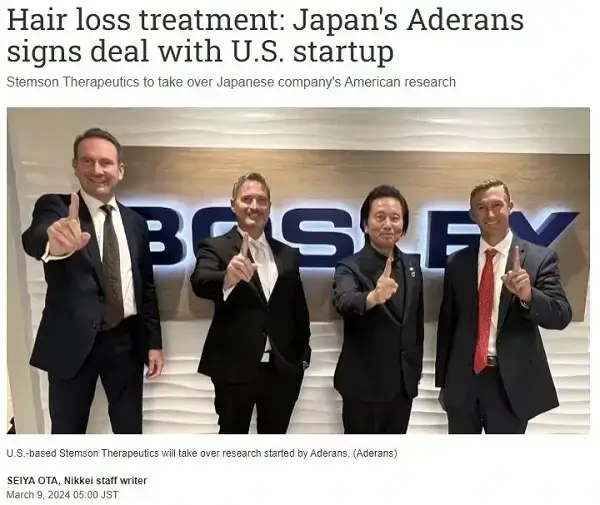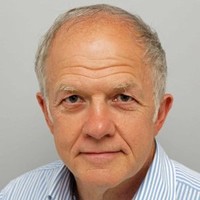In a first for this blog, I am updating a post from ten years ago! Perhaps I should change the title and remove the word “failure”? I wonder how many of the original 15 commentators are still visiting this site?
Update: March 9, 2024

Stemson Therapeutics and Aderans Announce Licensing Deal
Earlier today, Stemson Therapeutics (US) and Aderans (Japan), the parent company of Bosley® and HAIRCLUB®, announced a partnership agreement (licensing deal).
This arrangement secures Stemson the exclusive global rights to research, develop and commercialize hair regeneration therapeutic products based on Aderans’ proprietary hair regeneration cell therapy technology. Note that Aderans and and Intercytex represented the only two major hopes for a hair loss cure throughout the 1990s and early 2000s. And then companies both folded and made me originally write this post a decade ago.
Stemson today likely represents the number one hope for a hair loss cure, although there are a number of other contenders in China, Japan, South Korea and the US. At least when it comes to much improved hair loss treatments
Getting back to Stemson, the company is developing a proprietary cell therapy for reversing hair loss that is based on induced pluripotent stem cells (iPSC). Per the press release, it now:
“Gains a complementary technology through this agreement. Stemson will resume Aderans’ Phase 2 clinical stage cell therapy hair regeneration program, integrate the technology into its existing hair loss cell therapy development pipeline, and provide multiple products for patients experiencing hair loss.”
What a great development. Aderans is back from the dead. It also seems like a backup plan for Stemson in case its main iPSC technology does not pan out. Moreover, Stemson seems to want to resume Phase 2 trials for Aderan’s hair regeneration technology. And Japan has more favorable regenerative medicine sector regulations when it comes to trials and in-clinic use.
Quote from Stemson CEO Geoff Hamilton:
“The synergies between the Aderans technology and Stemson’s in-house technology will help us accelerate timelines across our programs.”
Quote from Aderans CEO Yoshihiro Tsumura:
“We look forward to working with the Stemson team to enable their development efforts and to support the commercialization through our global network of clinics serving hair loss patients.”
Quote from the evergreen Ken Washenik (Chief Medical Officer of Bosley Medical and former CEO of Aderans Research Institute):
“Our pioneering work at the Aderans Research Institute to develop the first ever cell therapy solution for hair loss showed tremendous promise in clinical trials to treat early stage Androgenetic Alopecia in men and women. We believe Stemson, with their advanced expertise in hair follicle cell and tissue engineering, is ideally positioned to successfully complete development and commercialization of this exciting hair regeneration solution.”
November 25, 2014
Aderans and Intercytex: Hair Multiplication Failure
All the great news this year related to hair loss research, trials and potential cures has made people very optimistic. However, a lot of hair loss sufferers are becoming excessively passionate about a select few companies (especially Histogen and Replicel) or about the results from a select few clinical trials.
I therefore decided to write this post as a warning from past experiences of putting too much faith into any one or two entities. Something as simple as lack of sufficient funding despite successful stage 2 clinical trials can cause a company to stop pursuing highly promising products.
In the early-to-late 2000s, two companies named Aderans (Japan) and Intercytex (UK) caused tremendous excitement in all the online hair loss forums. Both were involved in groundbreaking research related to hair cloning and hair multiplication.
Moreover, Aderans’ research was led by the renowned Dr. Ken Washenik through the Aderans Research Institute. He made numerous presentations about their technology at various conferences. Below are two of those:
However, in 2013, Aderans decided to liquidate its research institute. Spencer Kobren had a segment about this on his usually weekly Bald Truth show. Also starring legendary hair loss sufferer and caller “Joe from Staten Island”.
Intercytex abandoned its dermal papilla cell culturing work in 2010 due to financial difficulties, despite positive results from phase 1 trials. According to the company’s website, in 2010 the Intercytex name and ICX-RHY were purchased by private investors and relaunched as Intercytex Ltd. ICX-RHY is a skin repair product.
As of 2014, Aderans’ research is focused on wigs and hair replacement. They purchased US-based hair restoration market leading companies Hair Club in 2013 and Bosley in 2001. Intercytex as a company is no longer in existence.
